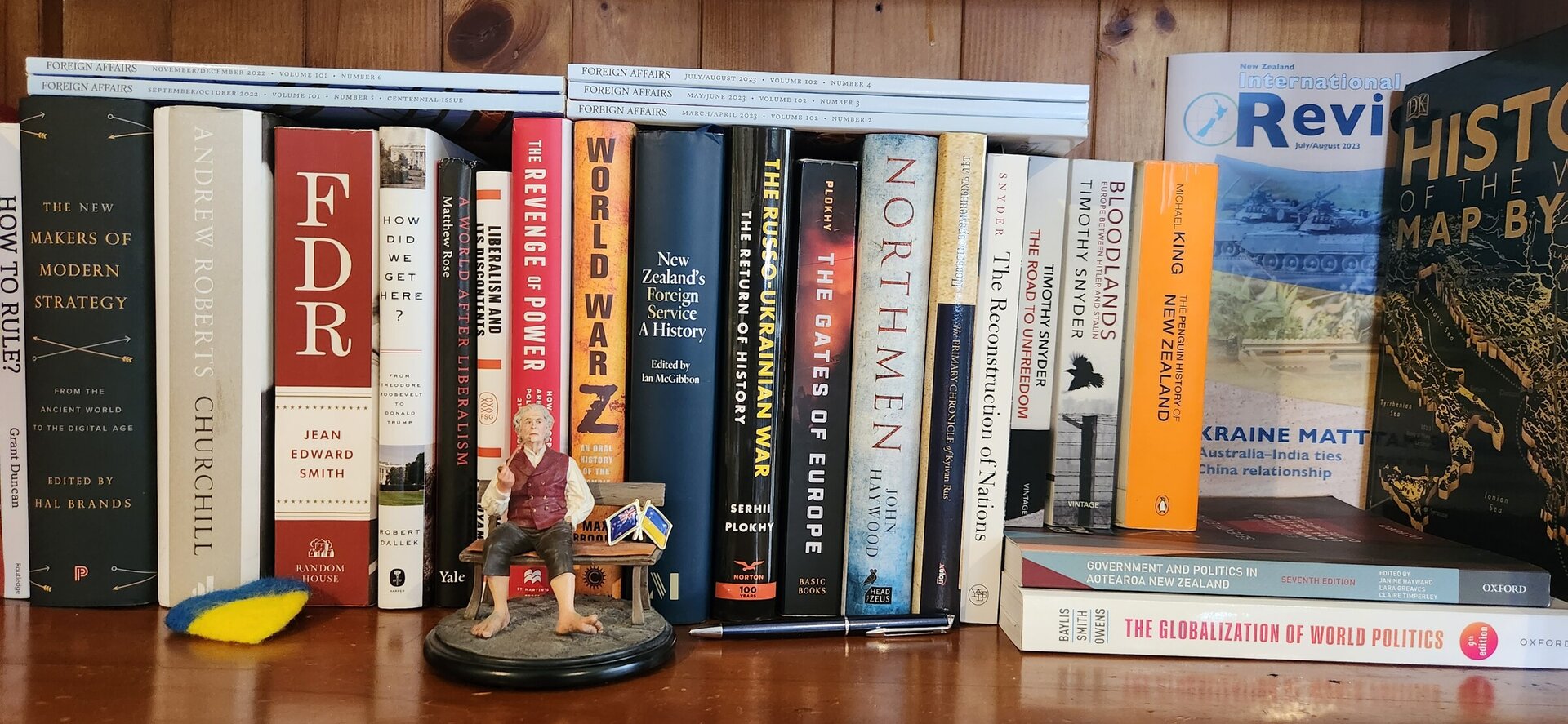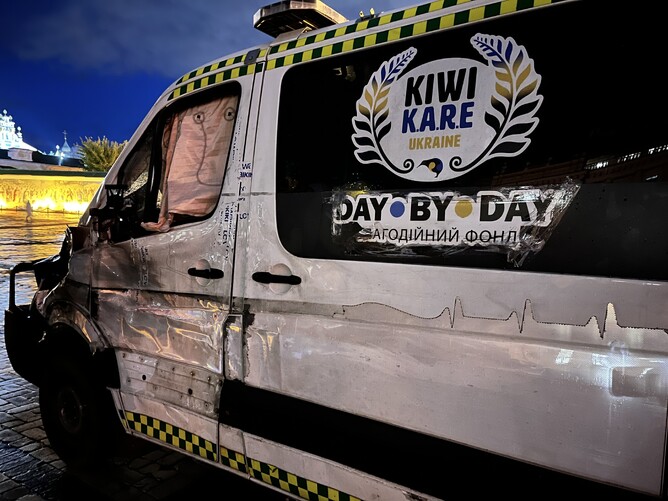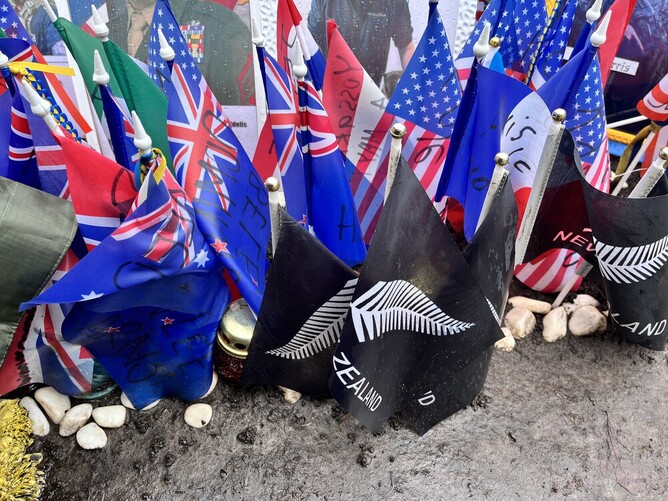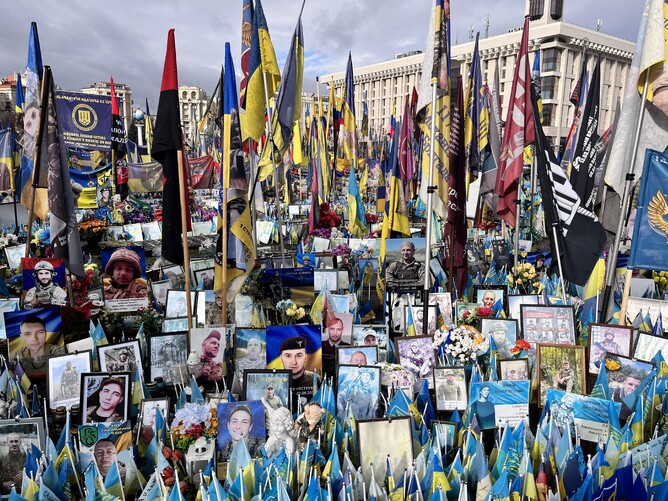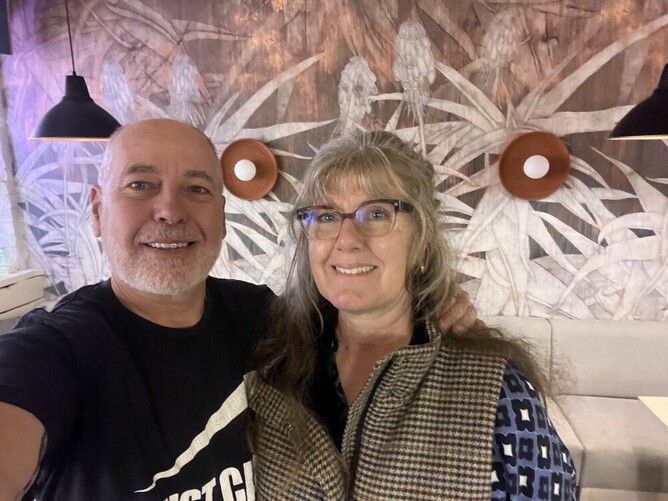Kiwi K.A.R.E. Director on Aid Deliveries
The following article is based on an interview with Tenby Powell in Kyiv, in October 2025. Kathy Lloyd travelled to Kyiv to meet and interview full time humanitarian and defense volunteers working to support civilians and frontline defenders under attack by Russian drones, missiles, bombs and artillery.
What does it take to effectively deliver multi-faceted humanitarian aid to people living close to Ukraine’s 1200- Kilometer-long frontline, who daily endure the hell of being stalked by drones or systematic war crimes characteristic of occupation by Russian military forces?
I recently had the opportunity to put this question to Tenby Powell, the hands-on founder of New Zealand’s humanitarian aid partnership with Ukraine, Kiwi Aid and Refugee Evacuation, “Kiwi K.A.R.E.”
Ambulance "Aroha", one of 40 New Zealand donated or purchased ambulances, now stands in Mykhailivs’ka Square in central Kyiv. Ambulances and other rescue missions are regularly attacked by Russian drones.
Tenby spends a significant amount of time directing and managing operations in the war-ravaged frontline regions of Sumy, Kharkiv, Donetsk, and Kherson, and I was fortunate to meet with him during my brief visit to Kyiv.
Kiwi K.A.R.E is one of two New Zealand founded Ukraine charities I’ve supported since Russia invaded Ukraine in February 2022. After supporting many volunteers – including individuals and Ukrainian registered charities whose teams I have come to know – I wanted to personally meet and interview several of the outstanding and dedicated heroes of the enormous volunteer effort that has sustained Ukraine’s defense and survival since long before 2022.
Tenby’s incredible leadership is evidenced by developing successful, legally binding partnerships between New Zealand’s Kiwi K.A.R.E and four Ukrainian counterparts “Day by Day Foundation”, VSI Poruch, iHELP Foundation, and Phoenix Foundation. Together they manage the delivery and operations of the “Road of Life”, “Heat for Health”, and “Relief Aid” outreach programmes. Together, these three programmes provide agile and practical delivery of civilian evacuations and patient transfers, the fabrication and distribution of stoves and water boilers (recycled from unserviceable electrical hot water cylinders), and the delivery of medical/humanitarian aid to red zone hospitals and medical units.
Flags commemorating the lives of New Zealand volunteers killed while volunteering in Ukraine on display at Maidan (Independence) Square) in Kyiv. One of the flags commemorates Andrew Bagshaw, killed while attempting to evacuate a civilian
Kiwi K.A.R.E. is privately funded through crowdfunding on the New Zealand Givealittle platform and international partners, and receives no government funding, although it fills a vital niche not serviced by the larger pools of humanitarian aid funding that the New Zealand government contributes to.
How did a small private New Zealand charity end up delivering a $60 million humanitarian impact, in life saving aid, vehicles and evacuations, to those far from the reaches of international aid NGOs?
A theoretical “Need vs Risk” axis defines the operating environment for humanitarian aid services in regions impacted by war. In theory three zones represent the degree of safety or risk and the degree of accessibility for civilian aid and medical personnel.
These three zones are a useful way to simplify what is in reality an active, dynamic war in which people and material goods and services are constantly transiting between the zones.
Ukraine was home to over 40 million people, and for those impacted along the northern, eastern and southern frontlines, many chose to stay in their homes, fearful of life as a displaced person or refugee.
The western and central parts of Ukraine, around 80% of the country, are free from active combat and remain governed by a strong functioning Ukrainian government. However, frequent barrages of weaponised drone, cruise missile and guided bomb attacks by Russia over most of the country, together with the additional demands of 5-6 million internally displaced civilians has resulted in significant stress on infrastructure and resources. This 4th winter of full-scale war promises to be the most difficult due to sustained Russian attacks on energy and water infrastructure, and residential housing.
In these western and central regions of Ukraine, international aid personnel can actively work in what is a still a functioning country, engaging with a capable and active civil society via social media and other digital technologies.
At Kyiv's Maidan (Independence) Square, thousands of commemorative flags and photos are lovingly tended in a dynamic unofficial shrine to honour the heroic sacrifices of Ukrainian and foreign defenders.
Ukraine’s humanitarian needs are not being met in the high-risk, high-needs zone to the north, east and south of the country, where Kiwi K.A.R.E is one of the largest remaining operations still running after three and a half years of work in the war zone.
Access into the 1200 km “hot zone” of fighting, drone attacks and contested areas, is limited. “Liberation” of previously occupied areas does not bring instant peace or security, tactics of warfare evolve and change, communications infrastructure is often destroyed along with entire towns, cities and villages.
The security risks to humanitarian operations and personnel are extremely high due to targeting of evacuation, rescue, medical and aid personnel and vehicles by Russian artillery, attack drones and snipers, as well as the grave danger posed by unexploded ordinance and landmines.
The brutal reality is that evacuation of civilians from the ‘hot zone’ for medical reasons or to safety often falls to volunteers. Bear in mind that military medical evacuation personnel are constantly working in the ‘hot zone’ to rescue and treat wounded Ukrainian defenders, the conditions for evacuation of civilians can be just as dangerous. Rescue missions of any kind are at extreme risk due to the expanded ‘kill zone’ that resulted from increased use of medium-range drones as fighting units pulled back positions and logistics out of reach from the shorter range FPV drones. Russian forces continually attack humanitarian convoys, steal humanitarian supplies, kill rescue workers and evacuation drivers and medics.
Many Western funded aid organisations did not have extensive prior experience in Ukraine, and struggle to operate in ‘hot zones’ or siege conditions under Russian military occupation. The combined effect of sanctions, insecurity and risk of being direct targets, together with a lack of military operational capability seems to directly work against organisational capability where they are most needed, according to Tenby. Tenby shared that in 2022, his programme agreed to deliver humanitarian aid packages on behalf of the Red Cross and World Food Program (WFP). He also noted that his teams do not typically see the big international aid agencies visibly operating in the ‘hot zones’ where the highest needs of those most vulnerable comes with highest risk.
Flags of fallen defenders, now numbering in the tens of thousands, and displayed on the site where young Ukrainians protested in 1990, 2004 and in 2014, are a sombre and tragic reminder of the brutal cost of Russian tyranny. Ukrainians defend their right to exist and choose the path to European laws and democratic institutions
I know from my own experience supporting fundraising for basic equipment and vehicles needed by volunteer and military medical units, that the needs are not met by existing government or international aid funding, and private crowdfunding continues to be a pillar for Ukraine’s defense and humanitarian needs. This begs the question of why so many countries who actively support Ukraine’s military training, equipment, logistics and provide funding for international humanitarian organisations, have not ensured that the funding is spent on those who have the highest needs. Why this should be in the ‘too hard basket’ is unclear, when a well-managed private charity such as Kiwi K.A.R.E. has demonstrated remarkable effectiveness and efficiency in its set up.
Unlike these large international, professional dedicated humanitarian aid delivery organisations, Tenby’s leadership offers a broader range of vital capabilities underpinned by his experience in business, governance, military service, and charitable/not-for-profit organisations. Tenby gained a Master of Management Studies in International Business with First Class Honours from the University of Waikato, and was awarded Distinguished Alumnus in 2010. He attended Harvard Business School and was educated in the New Zealand Defence Force where he holds the rank of Colonel in the Royal New Zealand Infantry Regiment. He has senior management experience in leading New Zealand corporations such as Fletcher Challenge and Skellerup Group, and runs a private investment company, Hunter Powell Investments Limited.
This mix of commercial, military, government, and not-for-profit experience has created a rich and deep cross-sector knowledge base – and we can see the results clearly in the success of Kiwi K.A.R.E. working so effectively with diverse cultural and socio-economic groups, as well as crowdfunding from the New Zealand Givealittle platform. And for every dollar spent on administration and necessary overheads, Kiwi K.A.R.E. donates $8 in direct aid to Ukrainians – this is possible due to the ongoing use of volunteers rather than paid professionals, with a consequent reduction in staffing costs.
To date, Kiwi K.A.R.E. has delivered:
· Fabricated and distribution of more than 5,500 stoves and water boilers to families and hospitals for heating through Ukraine’s harsh winters
· Completed more than 650 humanitarian missions, evacuating around 5,000 civilians
· Delivered 37 ambulances and seven support vehicles to medical units in high-risk regions, including Sumy, Kharkiv, Donetsk, and Kherson.
· Total humanitarian aid impact valued at $60 million since 2022.
Speaking of overheads, protection from attack drones is now a necessary cost for all aid vehicles operating near the expanded ‘kill zone’ (which can stretch up to 40 km wide). Anti-drone systems are now included when kitting out operational vehicles.
Some of the factors that Tenby credits for the success of the delivery programmes in Ukraine include increasing reliance and training of Ukrainian volunteer teams, who can communicate and work with ease with the Ukrainian civilian recipients of the aid. It also involves respect for each person choosing to be evacuated from their home in a ‘hot zone’ or to remain there due to the enormity of the prospect of becoming an internally displaced refugee, often later in life.
What does the future hold for Kiwi K.A.R.E. and its vital programmes in Ukraine’s war-torn regions?
Tenby doubled down on his commitment to continue serving with those extraordinary individuals supporting Ukraine during its darkest days and says Kiwi K.A.R.E. intends to stand beside the Ukrainians until the war ends, as recently quoted by Kyiv Post.
The question of whether humanitarian aid paid for by private donors or official sources reaches the people whose survival depends on it the most, is not hypothetical. Ukraine’s allies should be concerned whether their aid reaches those living and dying under skies where the machinery buzz of attack drones replaced birds long ago.
The author meeting Tenby Powell, Kiwi K.A.R.E founder in Kyiv, October 2025
Sources:
Kathy Lloyd, Former Ministry for Primary Industries Market Access Counsellor, Former NZ Registered Veterinarian, Director and Consultant at Waka Kuaka Ltd. Volunteer advocate for support for Ukraine’s defense, territorial sovereignty and humanitarian needs.
Fundraising for Ukraine: https://givealittle.co.nz/cause/ukrainian-medics-first-responders-and-defenders
Tenby Powell, Director Kiwi K.A.R.E. (Kiwi Aid & Refugee Evacuation)
https://givealittle.co.nz/cause/kiwi-kare-ukraine-kiwi-aid-and-refugee-evacuation
